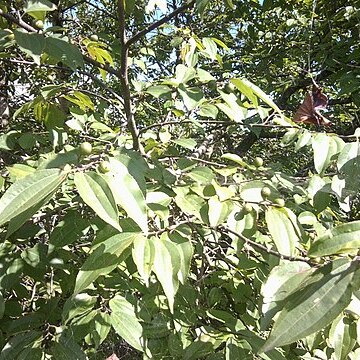Trees to 15 m tall or large shrubs, spinose. Young branches brownish pilose; old branches black-brown or purple-black, stiff, stout. Stipular spines 1 or 2, erect, 4-6 mm, caducous; petiole 5-11 mm, brownish pilose; leaf blade abaxially pale green, adaxially dark green, ovate to elliptic, rarely ovate oblong, 5-14 × 3-6 cm, papery, abaxially with pubescent or sparsely hairy veins, glabrescent, adaxially glabrous or sparsely pubescent on primary vein, 3(or 5)-veined from base, base rounded to slightly cordate, often slightly asymmetric, margin crenate-serrate, apex acuminate or shortly acuminate, obtusely mucronulate, rarely subrounded. Flowers greenish, several to 10 in axillary dichotomous cymes; peduncles 7-16 mm, brownish pilose. Sepals ovate-triangular, abaxially pilose, adaxially glabrous, distinctly keeled up to middle, apex acute. Petals spatulate, subequal to stamens, clawed. Disk thick, fleshy, 5-lobed, distinctly emarginate in front of stamens, outer margin prominent. Ovary globose, apex puberulent; styles 2-branched, divided to half. Drupe red-brown at maturity, subglobose or globose-ellipsoid, 1-1.2 × 0.8-1.1 cm, glabrous, with persistent calyx tube and disk at base; fruiting pedicel 4-11 mm, pilose; mesocarp thin; endocarp ca. 3 mm, thickly cartilaginous, (1 or)2-loculed, with 1 or 2 seeds. Seeds black-brown, shiny, smooth. Fl. Apr-May, fr. Jun-Oct. 2n = 24.
More
A medium sized tree. The leaves have stalks. They are 2-11.5 cm long by 1.5-6 cm wide. They are oval and taper to the tip. There are teeth. There are 3 veins. The flowers are small and yellowish. They occur in flat topped arrangements in the axils of leaves. The fruit are reddish brown.


